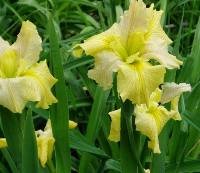 The Louisiana Iris Suite
The Louisiana Iris SuiteImages and reflections by Dick Sloan
Hybridization,
Seeds & Seedlings
Above is 'Amber River', 1985, the most adaptable and best performing of three irises I registered and introduced when I lived in southern California. A beautiful yellow pendant formed flower, named for my mom, has not proved a good grower, but 'Amber River' remains a beauty and grows very well. The yellow, 'Ruth Sloan', was introduced with a color picture on the cover of the American Iris Society Bulletin.
'Edmond Riggs' is my 2003 introduction. It was recorded
as a cross of my 1985 'Amber River' and 'Brushed Gold', a 1982
registered unfading yellow by Morgen of the Little Rock area.
When I sent in the registration, ($7.50 plus choosing a name
not already used plus if named for a person, one must have permission
from the individual or heirs, or wait ten years after the death
of the individual) I recorded it as from unknown parents, because
I could see no resemblance to the recorded parents. Since  then,
I have begun to believe the record may be correct. I was given
permission to use Mr. Riggs name one year short of the 10th anniversary
of his death, because in an interview he said he would have no
one to bury him.
then,
I have begun to believe the record may be correct. I was given
permission to use Mr. Riggs name one year short of the 10th anniversary
of his death, because in an interview he said he would have no
one to bury him.
He was probably the only African-American to register and introduce Louisiana irises, over 20 in 1944, one by Mrs. Riggs. He used such great names as 'Evangeline', a yellow, 'Lafayette', a red, and 'La Louisiana', a blue blend. They were irises collected from the swamps, probably many I. nelsonii, or bee cross hybrids from the garden. He was an interesting person, self-educated, the mix of all the races which inhabited south Louisiana, but he probably would not have been allowed to attend society meetings or exhibit at shows. Thankfully, times have changed, but he wasn't remembered in time to honor him during his lifetime. He published plant lists and grew a variety of plants as well as fighting cocks. In later years he drove the library truck through the projects, giving kids a taste of a wider world from books. I thought it fitting to name an iris for him. I would have been honored to be his friend.
This is my 'Lineage', just registered and to be introduced in 2004. It's one of those with the webbing or veining over the petals.
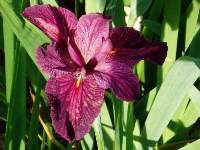 This
is a late season mature bloom on 'Acadian'. The light colored
powder below the light line area of the flower are pollen grains.
When a bumble bee follows the yellow line signal into the flower
to drink the nectar, some of the pollen will cling to it. When
it moves to another mature flower, some of this pollen will adhere
to the sticky material on the light line area (stigmatic lip)
on that flower. The pollen then sends a tube down to that flower's
ovary and seeds are formed, up to 70.
This
is a late season mature bloom on 'Acadian'. The light colored
powder below the light line area of the flower are pollen grains.
When a bumble bee follows the yellow line signal into the flower
to drink the nectar, some of the pollen will cling to it. When
it moves to another mature flower, some of this pollen will adhere
to the sticky material on the light line area (stigmatic lip)
on that flower. The pollen then sends a tube down to that flower's
ovary and seeds are formed, up to 70.
Pods can have as many as 70 seeds. Bumble bees are the natural pollinators. Here, some creature lays eggs on or near the pods and pin holes show, later as pods develop, that something has eaten seeds. The way to avoid this is to tie sections of panty hose over the developing pod. Seeds should be planted in the fall before they are too dry, to give speedy and fairly complete germination. Some will germinate the same fall, others the next spring. Dry seeds germinate slowly over years. I use kitty litter trays for seedlings and bring them in during the winter to avoid freeze damaging the small plants that have germinated in the fall. One must poke the seeds back into the medium as they are natural floaters, large and corky. They are happy if kept almost saturated, and will bloom the second spring if treated well.
In 2000, I planted seeds in a pot -- not the best way, but they germinated the next year. In the fall of 2001, those that survived with little or no care were planted in the ground as the contents of the pot were slipped out and into a hole. By 2002, only a few survived in the crowded mass. I lined out what I thought were the three survivors. This spring they bloomed.
The first was a large vigorous rose maroon bitone. It is pretty,
but may be shy of buds, and is not distinctive. I will discard
it, though first year bloom is not typical. The second was a
tall stalked, small flower with an attractive shape, cream yellow
with an orchid wash on first opening and tall for the flower
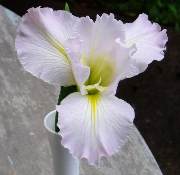 size.
Subsequent blooms lack the orchid tint, which was concentrated
on the edges of petals. The third, at the right, is similar in
flower size on a shorter stalk, all in proportion, and a lovely
pale pink shade which matures to near white. Definitely a keeper
to see again.
size.
Subsequent blooms lack the orchid tint, which was concentrated
on the edges of petals. The third, at the right, is similar in
flower size on a shorter stalk, all in proportion, and a lovely
pale pink shade which matures to near white. Definitely a keeper
to see again.
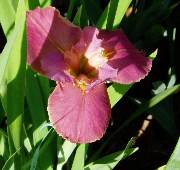 The
fourth was considered part of the large vigorous sibling when
I transplanted them. It is a smooth rose, with a thin tan halo-the
edge around the fall petals. After a few days, I realized it
looked very like Hutchison's 'Richard's
Pink', so made a close inspection, though the two plants
have never grown near each other. Small differences in the coloring
of the style arms show. The seedling has the halo, or did on
early blooms (not evident now) and early blooms showed some serration
along the petal edges. Another keeper.
The
fourth was considered part of the large vigorous sibling when
I transplanted them. It is a smooth rose, with a thin tan halo-the
edge around the fall petals. After a few days, I realized it
looked very like Hutchison's 'Richard's
Pink', so made a close inspection, though the two plants
have never grown near each other. Small differences in the coloring
of the style arms show. The seedling has the halo, or did on
early blooms (not evident now) and early blooms showed some serration
along the petal edges. Another keeper.
First year blooms can never be judged. I will discard the vigorous rose maroon and the too tall small flowered yellow, contradicting what I just said, but I am short of space, have arthritis, and at 74, less energy than formerly, and have over 20 newer varieties ordered, so must be ruthless.
I was well rewarded for giving so little care to these seedlings, and will look forward to seeing the real survivors next season. Of course, the breeding records are gone too. I don't deserve such a rich reward.
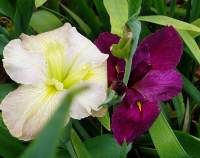 This
picture shows 'Edmond Riggs' with one of its siblings. The deep
maroon purple was given the garden name "Victorian Velour"
but will be discarded as the blooms wilt rapidly. The parents
were a golden yellow and an amber. Other siblings included two
golden yellows, rejected when the flowers were plain and the
color faded over the first day. Another was a red, again with
This
picture shows 'Edmond Riggs' with one of its siblings. The deep
maroon purple was given the garden name "Victorian Velour"
but will be discarded as the blooms wilt rapidly. The parents
were a golden yellow and an amber. Other siblings included two
golden yellows, rejected when the flowers were plain and the
color faded over the first day. Another was a red, again with
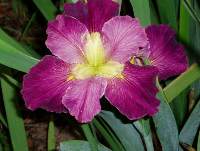 rapidly
wilting flowers. Another is still under consideration, pictured
at the left. I gave it the garden name "Moonlit Dusk"
and went so far as to check the name against the American Iris
Society books of R&I (Registrations and Introductions) to
find it still unused, but am still undecided both on name and
plant. Perhaps that is a hint to not offer it to other growers.
I tried to think of a name that reflects the light center against
the dark petals. However, this name doesn't roll trippingly off
the tongue, at least to me.
rapidly
wilting flowers. Another is still under consideration, pictured
at the left. I gave it the garden name "Moonlit Dusk"
and went so far as to check the name against the American Iris
Society books of R&I (Registrations and Introductions) to
find it still unused, but am still undecided both on name and
plant. Perhaps that is a hint to not offer it to other growers.
I tried to think of a name that reflects the light center against
the dark petals. However, this name doesn't roll trippingly off
the tongue, at least to me.
From The Heart | Contrasts | The Arkansas Hybridizers | From Australia
The Ladies | Hues | The Haymon Irises | The Species
My Introductions, Hybridizing, Seeds & Seedlings
Profile - Dick Sloan
